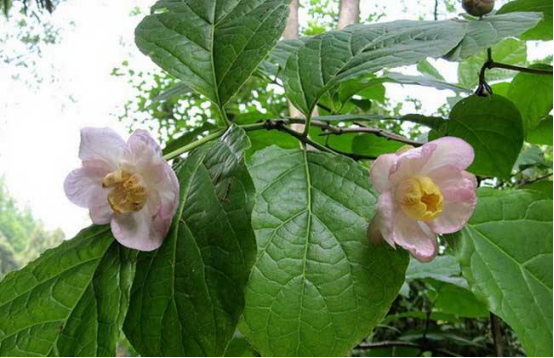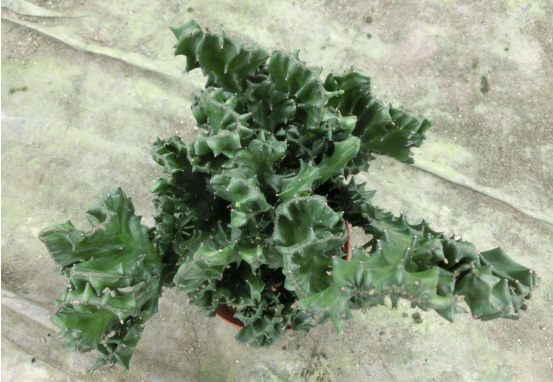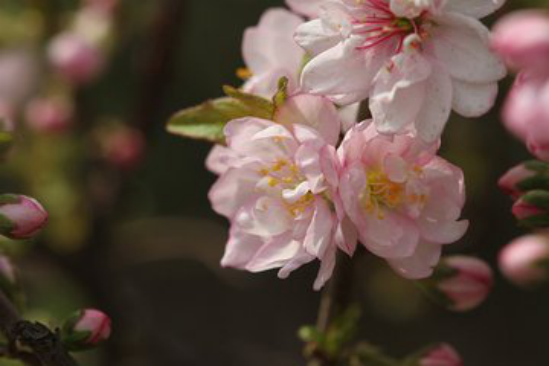Propagation methods of summer plum
one。 Sowing method
From October to November every year, the achene shell of Chimonanthus changes from green to yellow, and the internal seeds are brown and black, and the seeds can be harvested, taken out and stored after drying. Attention should be paid to maintain the humidity of the seeds during storage. Spring and autumn are both seasons for sowing.
It is necessary to accelerate germination for 24 hours before sowing, that is, to soak the seeds in warm water in order to ensure a high budding rate. In addition, using well-drained moist soil as seedbed can also effectively improve the survival rate of seedlings. Summer plum needs shade in seedling stage and should be covered with anti-freezing in winter. The mature summer plum is suitable to be planted in a dry environment without strong light.

two。 Strip pressing method
From February to March every year, 1-2-year-old branches are selected to grow and thrive, cut the part of the soil with a knife, sprinkle a little ATP rooting powder on the wound, then bury it in the soil with carrageenan ash as the medium, often keep the soil moist, take root and transplant in about 2 months, and bloom in the same year.
Culture methods and matters needing attention of summer plum
Culture methods of summer plum: temperature and light
Summer plum can survive winter and summer normally in Jiangnan and other places, and can withstand short-term high temperature of 40 ℃ and severe cold of-15 ℃. Like warm and humid, the sun is not strong growth environment, in full light leaves turn yellow, poor growth, so to avoid direct sunlight, long-term exposure to the sun, the right amount of light can be.
Watering
Chimonanthus is resistant to drought and waterlogging, and the soil can be kept semi-moist. Drainage in time during the rainy season. But in summer, there can be no shortage of water, so as not to form dry and whitish patches on the leaves and affect the formation of flower buds. In the flowering period of summer plum, the amount of water must be reasonable. If there is too little water, the flowers will bloom irregularly; too much watering will easily lead to falling flowers and buds.
Soil
It is suitable to grow in fertile and loose sandy soil with good drainage. The basin soil can be prepared with the same amount of sand slope and coniferous humus.
Fertilizer application
Like fertilizer, timely fertilization can promote flower bud differentiation, bloom more, apply leaf fertilizer twice in spring, apply compound fertilizer every half a month from the end of June to the end of June, promote the formation of flower buds, fertilization is mainly phosphorus and potassium fertilizer, appropriate amount of nitrogen fertilizer. Cake fertilizer can be applied once after cool autumn to enrich flower buds. From anthesis to defoliation, topdressing was applied for 2-3 times. Apply thin horseshoe water again before winter to provide nutrients for flowering.
Matters needing attention in summer plum culture pay attention to the control of diseases and insect pests
There are mainly scale insects and aphids, black spot and anthrax, especially in high temperature season.
Pay attention to the wind
Chimonanthus przewalskii is afraid of the wind, so it is necessary to choose a leeward place for open field cultivation. If the windbreak is not in place, the leaves will rust due to mutual friction. If exposed to the wind in the flowering period, the bud is not easy to open, the petals will not stretch, and so on.
Timely pruning
Chimonanthus chinensis has strong branching power, and timely pruning is beneficial to promote more flower branches to germinate and blossom more. It is suitable for pruning after the flower fade to before the leaves, usually between March and June, and stop pruning after July. Cut off disease and insect branches, withered branches, cross branches, over-dense branches, etc., annual branches retain 2-3 pairs of buds at the base, cut off the upper branches, in order to promote branches, after the new branches grow two or three pairs of leaves, they will be coring once.
Propagation method of Prunus mume planting techniques of Prunus mume
Summer plum, also known as peony, yellow loquat, etc., belongs to the deciduous ornamental flowers and trees of the genus Prunus mume of the family Prunus. They are mostly born on hillsides or valleys at an altitude of 600 to 1100 meters. The flowers are large and beautiful, and have great ornamental value. They are rare wild flowers endemic to China and are listed as second-class national protected plants and Tertiary relict species. Let's take a look at the planting techniques of summer plum.
The growing environment of summer plum
Summer plum likes warm and humid environment, strong adaptability, can survive winter and summer normally between Jiangnan and Jianghuai, can withstand short high temperature of 40 ℃ in summer, can resist severe cold of-15 ℃ in winter, avoid water humidity, grow exuberantly in wet sandy soil with good drainage, strong leaf color, yellow leaf color, poor growth and strong sprouting ability.
Propagation methods of summer plum
1. Sowing and propagation: summer plum seeds mature in mid-late October and can be picked when the pot-shaped fruit sac changes from green to yellowish brown and achenes are purple-brown. After picking, the seeds should be removed and prepared, and the seeds should not be too dry when stored. Soak the seeds in cold water for 24 hours and 28 hours before sowing in early spring to make the pericarp swell and sprout ahead of time. Sowing should be covered with grass to moisturize, generally about half a month can be unearthed, two months can basically come out. After the seedlings come out, remove the grass, and then build a shed for shade to prevent the seedlings from being burned by the scorching sun. Generally speaking, the height of the seedlings can reach 30 cm, the root length is 20cm to 25cm, and the aboveground part has 3 bifurcations, which can be transplanted and planted in bed for one year. Generally, the seeding seedlings can bud and blossom in 4-5 years.
2. Ramet propagation: summer plum can also use its root sprouting for ramet propagation. When ramet, the plant is dug out with a shovel, the root is shaken off the soil, and the sprouting tiller is divided into several small plants with a sharp knife or branch shears. Each small plant needs to have 1-2 main branches, and then the ramet trunk is left at lO cm to cut off, and then planted. Ramet should be carried out after defoliation in autumn to before sprouting in spring.
Planting techniques of summer plum
1. Planting method: open-field cultivation should choose humid and weak light environment. When transplanting, big seedlings should carry soil balls, the planting depth should be the same as in situ, low-land planting should be filled with higher soil to prevent stagnant water, when the soil alkalinity is too high, guest soil or improved neutral soil should be used, mature organic fertilizer should be applied as basic fertilizer before planting, and enough water should be irrigated after planting.
2. Pruning at the right time: Chimonanthus pruning can make it sprout more sturdy flower branches and blossom more. It is generally advisable to prune the withered branches, overdense branches, cross branches, disease and insect branches before they are blossomed. Leave two or three pairs of buds at the base of the annual branches, cut off the upper branches and promote the branching. After growing two or three pairs of leaves, the new branches will be pruned once to promote the sprouting of short and strong flower branches and the graceful shape of the plant. Pruning is mostly carried out from March to June, and stop pruning after July. If it is not pruned at the right time, it is easy to grow a lot of overgrown branches, consume nutrients, cause poor flower bud differentiation and affect flowering.
3. Timely fertilization: Chimonanthus przewalskii likes fertilizer. Timely fertilization can promote flower bud differentiation and blossom more. Chimonanthus chinensis planted in the ground can be ditched and applied thin fertilizer once a month, and do not apply thick fertilizer, so as not to flourish after autumn and affect flowering. Potted plants should choose loose and fertile soil. Leaf spreading fertilizer was applied twice in spring, and compound fertilizer was applied every 10 to 15 days from the end of June to the end of June to promote the formation of flower buds. Summer is the period of flower bud differentiation and vigorous growth of new roots, and phosphorus and potassium fertilizer can be applied again or twice, but fertilization should be thin at this time, otherwise it is easy to rot roots and cause leaves to yellowing and falling off. Cake fertilizer can be applied once after cool autumn to enrich flower buds. Apply thin horseshoe water again before winter to provide nutrients for flowering. The fertilization of Chimonanthus chinensis should be based on phosphorus and potassium fertilizer, the amount of nitrogen fertilizer is appropriate, and the general ratio of phosphorus, potassium and nitrogen is 4:2:1.
4. Proper watering: Chimonanthus is resistant to drought and afraid of waterlogging. Florists have the theory of "immortal Chimonanthus", but there should be no shortage of water in summer, so as not to form withered and white patches on the leaves and affect the formation of flower buds. It is appropriate to keep the soil in a semi-humid state. If too much watering, the plant growth is poor, affecting flower bud differentiation. Open-field cultivation should choose sunny and dry places, and pay attention to timely drainage in the rainy season. Flowering must pay attention to a good grasp of the amount of water, more water is easy to drop flowers and buds, less water, irregular blossoms.
5, pay attention to the wind: Chimonanthus is afraid of the wind, if you do not pay attention to the wind, the leaves will cause rust spots due to mutual friction. Due to the wind during the flowering period, the petals will not stretch, the bud is not easy to open, or the petals are scorched and wilted by the wind after flowering. To cultivate in the open field, you should choose the leeward and sunny place.
6. Disease and pest control
① scale insects: generally planted in dark tide wetlands, when it is rainy in summer, due to high temperature and muggy heat, wax plum is easy to suffer from scale insects, which can be controlled manually.
② aphids: the buds at the turn of spring and summer are susceptible to aphids. 50% aldicarb 3000 times liquid can be sprayed to eliminate this pest.
③ black spot: occurs in the high temperature season, can be sprayed with 65% Dysen zinc 500x solution or 0.3 Baomei flow mixture.
④ anthracnose: occurs in the high temperature season, can be sprayed with topiramate 800x solution.
- Prev

The breeding method of golden unicorn:
The best way to propagate the golden unicorn is to choose the method of cutting. Cut the cuttings from 8cm to 10cm from the top of the branches of the golden unicorn from May to June, wipe off the white pulp from the cut, and dip it in the plant ash here for 3 to 4 days.
- Next

Notes on planting wheat plums
In the growth process of wheat and plum, it is often infested by diseases, especially in September every year, which is the high incidence period of wheat and plum diseases. What should we do at this time? Don't worry, small editor to move, with carbendazim to treat OK! Another thing is that Miley likes to live in a sunny environment.
Related
- Fuxing push coffee new agricultural production and marketing class: lack of small-scale processing plants
- Jujube rice field leisure farm deep ploughing Yilan for five years to create a space for organic food and play
- Nongyu Farm-A trial of organic papaya for brave women with advanced technology
- Four points for attention in the prevention and control of diseases and insect pests of edible fungi
- How to add nutrient solution to Edible Fungi
- Is there any good way to control edible fungus mites?
- Open Inoculation Technology of Edible Fungi
- Is there any clever way to use fertilizer for edible fungus in winter?
- What agents are used to kill the pathogens of edible fungi in the mushroom shed?
- Rapid drying of Edible Fungi

